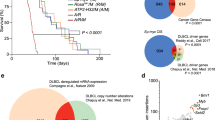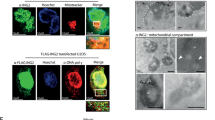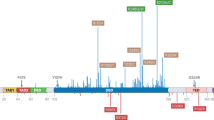Abstract
The complex apoptotic functions of the p53 tumor suppressor are central to its antineoplastic activity in vivo. Besides its well-known action as a transcriptional activator of apoptotic genes, p53 exerts a direct proapoptotic role at the mitochondria via protein–protein interactions with Bcl2 family members, thus executing the shortest known circuitry of p53 death signaling. We recently reported that exclusive delivery of p53 to mitochondria exerts a significant in vivo tumor suppressor activity in p53-null lymphomas. However, it was unknown whether mitochondrially targeted p53 has suppressor activities in tumors harboring missense mutants, which constitute the vast majority of p53 alterations in human tumors. Here, we show that targeting p53 to mitochondria does confer a significant growth disadvantage in B-lymphomas expressing various point mutants of p53, resulting in efficient apoptosis induction in vitro and in vivo in mice.
This is a preview of subscription content, access via your institution
Access options
Subscribe to this journal
Receive 50 print issues and online access
$259.00 per year
only $5.18 per issue
Buy this article
- Purchase on Springer Link
- Instant access to full article PDF
Prices may be subject to local taxes which are calculated during checkout



Similar content being viewed by others
References
Arima Y, Nitta M, Kuninaka S, Zhang D, Fujiwara T, Taya Y et al. (2005). J Biol Chem 280: 19166–19176.
Baylin SB, Ohm JE . (2006). Nat Rev Cancer 6: 107–116.
Chen L, Willis SN, Wei A, Smith BJ, Fletcher JI, Hinds MG et al. (2005). Mol Cell 17: 393–403.
Chipuk JE, Bouchier-Hayes L, Kuwana T, Newmeyer DD, Green DR . (2005). Science 309: 1732–1735.
Chipuk JE, Kuwana T, Bouchier-Hayes L, Droin NM, Newmeyer DD, Schuler M et al. (2004). Science 303: 1010–1014.
Dumont P, Leu JI, Della Pietra III AC, George DL, Murphy M . (2003). Nat Genet 33: 357–365.
Eischen CM, Weber JD, Roussel MF, Sherr CJ, Cleveland JL . (1999). Genes Dev 13: 2658–2669.
Erster S, Mihara M, Kim RH, Petrenko O, Moll UM . (2004). Mol Cell Biol 24: 6728–6741.
Erster S, Moll UM . (2005). Biochem Biophys Res Commun 331: 843–850.
Essmann F, Pohlmann S, Gillissen B, Daniel PT, Schulze-Osthoff K, Janicke RU . (2005). J Biol Chem 280: 37169–37177.
Harris AW, Pinkert CA, Crawford M, Langdon WY, Brinter RL, Adams JM . (1988). J Exp Med 167: 353–371.
Herman JG, Baylin SB . (2003). N Engl J Med 349: 2042–2054.
Hsu YT, Wolter KG, Youle RJ . (1997). Proc Natl Acad Sci USA 94: 3668–3672.
Kuwana T, Bouchier-Hayes L, Chipuk JE, Bonzon C, Sullivan BA, Green DR et al. (2005). Mol Cell 17: 525–535.
Leu JI, Dumont P, Hafey M, Murphy ME, George DL . (2004). Nat Cell Biol 6: 443–450.
Li PF, Dietz R, von Harsdorf R . (1999). EMBO J 18: 6027–6036.
Lim DS, Bae SM, Kwak SY, Park EK, Kim JK, Han SJ et al. (2006). Hum Gene Ther 17: 347–352.
Marchenko ND, Zaika A, Moll UM . (2000). J Biol Chem 275: 16202–16212.
Mihara M, Erster S, Zaika A, Petrenko O, Chittenden T, Pancoska P et al. (2003). Mol Cell 11: 577–590.
Nemajerova A, Wolff S, Petrenko O, Moll UM . (2005). FEBS Lett 579: 6079–6083.
Olivier M, Eeles R, Hollstein M, Khan MA, Harris CC, Hainaut P . (2002). Hum Mutat 19: 607–614.
Peng Z . (2005). Hum Gene Ther 16: 1016–1027.
Petros AM, Gunasekera A, Xu N, Olejniczak ET, Fesik SW . (2004). FEBS Lett 28073: 1–4.
Roth JA . (2006). Expert Opin Biol Ther 6: 55–61.
Sansome C, Zaika A, Marchenko ND, Moll UM . (2001). FEBS Lett 488: 110–115.
Sauthoff H, Pipiya T, Chen S, Heitner S, Cheng J, Huang YQ et al. (2006). Cancer Gene Ther doi: 10.1038/sj.cgt.7700936.
Schmitt CA, Rosenthal CT, Lowe SW . (2000). Nat Med 6: 1029–1035.
Talos F, Petrenko O, Mena P, Moll UM . (2005). Cancer Res 65: 9971–9981.
Yin S, Goodrich DW . (2006). Int J Oncol 28: 781–785.
Zhao Y, Chaiswing L, Velez JM, Batinic-Haberle I, Colburn NH, Oberley TD et al. (2005). Cancer Res 65: 3745–3750.
Acknowledgements
We thank Patricio Mena for animal care and Christine Eischen for providing two lymphoma isolates. This work was supported by grants from the National Cancer Institute and Philip Morris USA Inc./Philip Morris International to UMM.
Author information
Authors and Affiliations
Corresponding author
Additional information
Supplementary Information accompanies the paper on the Oncogene website (http://www.nature.com/onc).
Supplementary information
Rights and permissions
About this article
Cite this article
Palacios, G., Moll, U. Mitochondrially targeted wild-type p53 suppresses growth of mutant p53 lymphomas in vivo. Oncogene 25, 6133–6139 (2006). https://doi.org/10.1038/sj.onc.1209641
Received:
Revised:
Accepted:
Published:
Issue Date:
DOI: https://doi.org/10.1038/sj.onc.1209641
Keywords
This article is cited by
-
Increased acetylation of lysine 317/320 of p53 caused by BCR-ABL protects from cytoplasmic translocation of p53 and mitochondria-dependent apoptosis in response to DNA damage
Apoptosis (2012)
-
Resistance of mitochondrial p53 to dominant inhibition
Molecular Cancer (2008)
-
The p53 family and programmed cell death
Oncogene (2008)
-
p53's mitochondrial translocation and MOMP action is independent of Puma and Bax and severely disrupts mitochondrial membrane integrity
Cell Research (2008)
-
Monoubiquitylation promotes mitochondrial p53 translocation
The EMBO Journal (2007)



